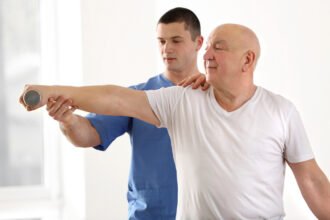Exercising is a vital part of staying healthy and in shape. However, it can come with certain nuisances that add discomfort to your workout, most notably, pain. While some aches and pains post-workout are typical, there are certain occurrences where you should take further precaution and consult a physician for the best course of action. Here are pain warning signs you should be on the lookout for during your workouts and set guidelines on whether paying closer attention to them or simply resting after they occur can help reduce risk and keep your exercise routine safe.
1. Sharp Pain
Sharp chest, shoulder, or abdomen pains can be warning signs of serious medical issues and warrant immediate medical attention. This pain is commonly experienced during exercise and usually feels like a sharp stabbing sensation that disappears quickly. If you’re experiencing sharp pains during your workout, stop immediately and consult a physician to evaluate it.
The same goes for any numbness you may experience in your extremities. Numbness can be a sign of poor circulation or even nerve damage, so if it becomes too much to bear, be sure to cease activity and see a doctor. You should also look out for any significant drop in performance. If you’ve been doing the same exercise for some time and suddenly find that your results are dropping off, it could be due to a medical issue.
2. Joint Pain
As we age, we become susceptible to pain during physical activity. When it comes to joint pain, the key is to determine whether it is short-term or long-term. If you’re dealing with any persistent aches or pains in your joints that don’t improve with rest, talk to a doctor about how best to manage them.
A holistic approach to joint health should be implemented, including a balanced diet, proper stretching and mobility exercises, and taking the right supplements. Emergency centers like
Complete Care have joint care programs that can help you create an individualized plan to keep your joints healthy and functioning correctly. You should also talk to a doctor about holistic approaches that may be best for your situation.
3. Muscle Pain
Muscle pain is one of the most common forms of workout-related discomfort and can range from mild soreness to more severe aches. If you’re experiencing muscle pain, you should begin with essential treatments like hydration, stretching, and massage. If the pain persists or worsens despite these measures, it’s time to take a break from exercise and have the issue looked at by a doctor.
You should also watch out for any signs of m uscle tears or strains. If you experience severe
pain while exercising accompanied by swelling, bruising, or a popping sound, it’s essential to cease activity and seek professional medical attention immediately.
4. Swelling
Swelling that appears during or after physical activity could be a sign of an underlying medical condition. Several issues, including poor circulation, injury, dehydration, and more, can cause swelling. If the swelling persists or worsens, stop exercising and consult your physician for further evaluation.
In some cases, swelling can be prevented or reduced with the use of compression garments worn during exercise. Compression clothing helps keep circulation steady and reduces the risk of swelling in joints and muscles. You should also make sure to stay hydrated and warm up your muscles before getting started to reduce swelling.
5. Localized Pain
If you experience localized pain in any one spot during your exercise, stop immediately and assess the situation. This type of pain often indicates an overuse injury or strain built up due to incorrect form or excessive intensity. Localized pain should be taken seriously as it could lead to long-term issues if left untreated.
If you are dealing with localized pain, the best thing to do is rest for at least a few days and start your exercise routine again but with a lighter intensity. Additionally, be sure to consult a doctor for advice on how to prevent re-injury in the future.
6. Pain That Worsens During Workout
Sometimes, you may not experience pain until you’re already in the middle of your workout. This is often a sign that something is wrong, so it’s important to immediately take note and cease activity. Pain that worsens during exercise could be caused by anything from an injury or tear to more serious medical issues like heart disease.
If you experience any type of pain that worsens during a workout, you should stop immediately and seek medical advice. It’s also essential to take the time to properly assess your activity level, as continuing to push yourself beyond your physical limits could lead to more severe risks down the road.
It is crucial to understand how to recognize different types of exercise-related pain and take the necessary precautions to prevent further injury. Be sure to listen to your body, stop exercising if you experience any form of pain or discomfort, and consult a doctor for advice on how best to manage it. You may need to change your exercise routine to suit your body’s needs better. You may also need to increase your flexibility, strength, and endurance through other forms of exercise, such as yoga or Pilates. Taking steps like these will help you stay safe while ensuring you get the most out of your workouts.









